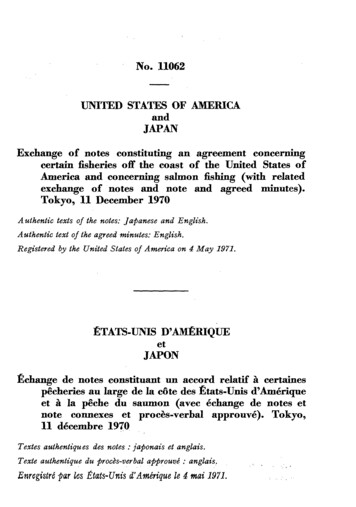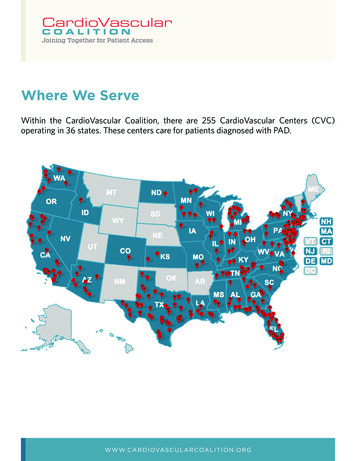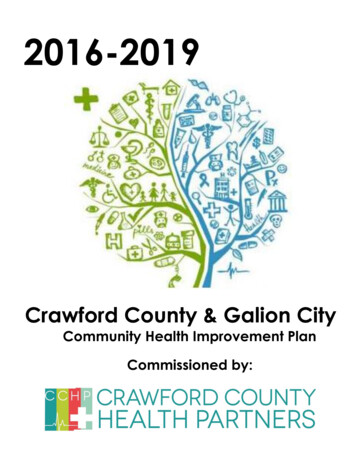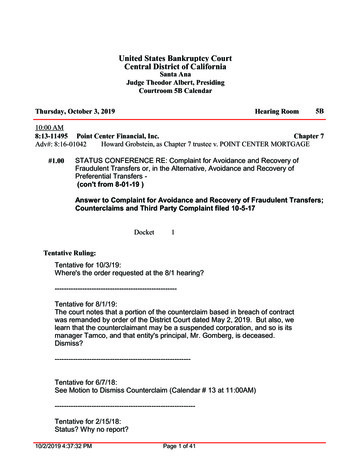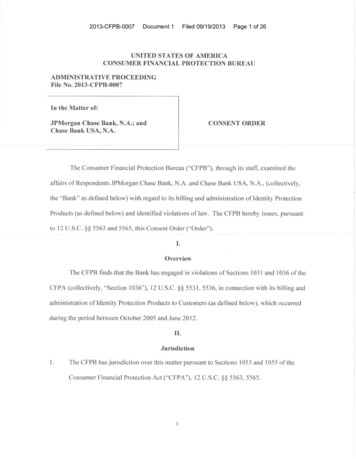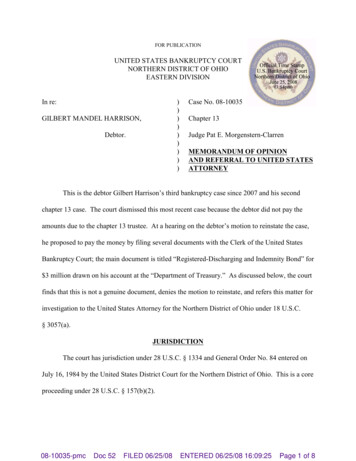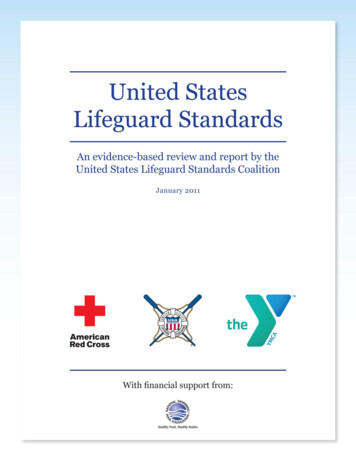
Transcription
United States Lifeguard StandardsPage 2 of 67January 2011ACKNOWLEDGMENTSSincere appreciation is extended to all of the individuals who dedicated their time and expertise to thedevelopment of the first outcomes and recommendations of the United States Lifeguard StandardsCoalition.Special thanks is extended to the National Swimming Pool Foundation, Colorado Springs, Co., for thegenerous donation that funded this project.The contributions and commitment to excellence by all involved made this project possible.
United States Lifeguard StandardsPage 3 of 67CONTENTSINTRODUCTIONThe ProblemHistory of CollaborationEstablishment of the CoalitionParticipants and ResponsibilitiesScope of the ProcessPROCESS AND METHODOLOGYEvidence-Based ProcessScientific Review and Evidence GradingReview ProcessEVIDENCE EVALUATIONS: THE QUESTIONSScanning TechniquesVigilanceInattentional BlindnessVisual and Behavioral CuesBreaks (Interruptions of Duty)AgeHearingVisionPhysical CompetencyUse of EquipmentAirwaySuctionCervical Spine InjuryOxygenOnline LearningREFERENCESJanuary 2011
United States Lifeguard StandardsPage 4 of LCORLOEMLFPSSSABCUSLAUSLSCWRCTAirway, breathing, and circulationAutomated external defibrillatorAmerican Heart AssociationAmerican Red CrossBasic life supportConfidence intervalConflict of interestConsensus on Resuscitation Science and TreatmentRecommendationsCardiopulmonary resuscitationEmergency medical systemsEmergency medical technicianInternational Liaison Committee on ResuscitationLevel of evidenceMinimum level of fitnessPhysical skill setSuction, airway, breathing, and circulationUnited States Lifesaving AssociationUnited States Lifeguard Standards CoalitionWater rescue competency testJanuary 2011
United States Lifeguard StandardsPage 5 of 67January 2011INTRODUCTIONWe are pleased to present the first outcomes and recommendations of the United States LifeguardStandards Coalition (USLSC), a project sponsored by the American Red Cross, the United StatesLifesaving Association (USLA), and the YMCA of the USA. The sponsors intend for theserecommendations to have a positive influence on the training of lifeguards and the practice oflifeguarding within their own organizations and, by freely sharing this research information and results,within other lifeguard training organizations as well. We have undergone this process maintaining theprinciple that best practice in lifeguarding should be based on the best and most scientific evidenceavailable, and that once that evidence is identified, it should be relevant for and apply to all lifeguardtraining.The ProblemAs lifeguarding has evolved, lifeguard training methods and standards have been established primarilyon the basis of experience and opinion. This can be a result of trial and error (or success), or of therecommendations of people who are considered to be experts. Just as experience and expertise vary indifferent organizations, so do methods and standards. In the case of some standards, the organizationspromoting them may not have an institutional memory regarding the reason the standards came to exist.The standards may simply have been accepted on the basis of historical adherence: ―We do it that waybecause we have always done it that way.‖A review of the lifeguard training standards advanced by various organizations, including the AmericanRed Cross, the USLA, the YMCA of the USA, and others, demonstrated that some practices differwithin the field. The role of a lifeguard, regardless of where trained or employed, is to prevent death andinjury. Using the best methods of training and standards of practice can therefore be expected to reducethe incidence of death and injury.At the beginning of this project, it was assumed that some high quality scientific studies had beenpublished within the scope of lifeguard training and standards that were not known to those developinglifeguard training programs. Another fundamental assumption was that by conducting a thorough reviewof the available scientific studies in related areas and by identifying areas of lifeguard training andstandards that are lacking a scientific basis, recommendations could be made to help ensure that futuretraining and standards are based on solid evidence. It was also assumed that in some areas where ascientific basis was lacking, ―best practice‖ should be followed, but that best practices must first bedetermined.History of CollaborationThe American Red Cross, the USLA, and the YMCA of the USA all are nationally recognized nonprofitorganizations, part of whose mission is the development and delivery of lifeguard training in a variety ofenvironments. All three are the US members of the International Life Saving Federation (www.ilsf.org).In 2003, the three organizations began discussing a formal collaboration. A key goal was to worktogether to identify best practices in areas that each organization had historically been relying primarilyon consensus expert opinion. This eventually evolved into a formal letter of understanding, under whichthe three organizations have been working since that time.
United States Lifeguard StandardsPage 6 of 67January 2011Establishment of the CoalitionIn 2005, the three groups formally announced a plan to establish guidelines for lifeguarding and watersafety. This project came to be known as the United States Lifeguard Standards Coalition (USLSC). Thevision of the founders was to establish a process of inviting a wide range of experts from allied fields;identifying key issues in lifeguarding that needed review, research, and resolution; researching existingscientific evidence on those issues; recommending best practices based on the evidence when possible;and when unable to recommend best practices, recommending additional research.Each organization appointed a chair based on demonstrated expertise in evaluating scientific researchand conducting evidence-based reviews. A wide variety of groups were invited to appointrepresentatives, and face-to-face meetings were conducted from 2006 through 2008. The coalitionbenefited greatly by grants from the National Swimming Pool Foundation, as well as from extensivecontributions of resources and personnel from the three sponsoring organizations and the many otherorganizations who provided experts.The sponsoring organizations identified agencies relevant to field of lifeguarding to assure a sound,unbiased process with multidisciplinary expertise and broad representation, and to allow for openevaluation, critique, and consensus. Various levels of participation (e.g., participant organizations,individual participants and observing organizations) were identified and representatives were invited toparticipate based on specific criteria. The descriptions, roles and responsibilities assigned to each levelof participation are listed below.In addition, a Web site (www.lifeguardstandards.org) with an e-mail contact address(info@lifeguardstandards.org) was established that listed the selection criteria. Through this site, otherorganizations could request to participate if they believed they met the criteria. In this case, thefollowing information was requested so that coalition members could determine eligibility: (1) contactinformation, (2) a description of the organization, (3) relevance of the individual ororganization/representative to the project, and (4) potential or real conflicts of interest. Organizationsthat did not qualify at the Participant level were offered the opportunity to be involved as Observers.Members of the media also were invited to participate via this Web site.Participants and ResponsibilitiesSponsoring OrganizationsAmerican Red CrossUnited States Lifesaving AssociationYMCA of the USAChairsDavid Markenson, MDChair of the American Red Cross Advisory Councilon First Aid, Aquatics, Safety and Preparedness(ACFASP)Peter Wernicki, MDMedical Advisor, United States LifesavingAssociationMember, International Life Saving FederationMedical CommitteeChair, ACFASP Aquatics Sub-CouncilGerald E. DeMers, PhDChair, Kinesiology Department, CaliforniaPolytechnic State University
United States Lifeguard StandardsPage 7 of 67Sponsoring OrganizationsAmerican Red CrossRepresentativesRoy FieldingStephen Langendorfer, PhDFrancesco A. Pia, PhDB. Chris BrewsterPeter Chambers, PhD, DOPeter DavisRalph L. Johnson, PhDTerri LeesLaura J. SlaneRepresentativesLinda Quan, MDTomas A. Leclerc, MSUnited States Lifesaving AssociationYMCA of the USAParticipant OrganizationsAmerican Academy of PediatricsAmerican Association for Physical Activityand RecreationAmerican Camp AssociationAmerican College of Emergency PhysiciansAmerican Heart AssociationAmerican Public Health AssociationBoy Scouts of AmericaInternational Life Saving FederationNational Intramural-Recreational SportsAssociationNational Park ServiceNational Recreation and Park AssociationUS Coast GuardUSA SwimmingFunding OrganizationNational Swimming Pool FoundationObserving Government AgenciesCenters for Disease Control andPrevention/National Center for InjuryPrevention and ControlNational Institutes of Health/National Heart,Lung, and Blood InstituteObserving OrganizationsAmerican Heart AssociationAmerican Red CrossCanadian Lifesaving SocietyCanadian Red CrossStarfish Aquatics InternationalRhonda MickelsonAndrew Butterfass, MD, FACEPWilliam HammillGreg FinlaysonDavid BellKeith ChristopherFrank C. ReigelmanSteve Beerman, MDCarrie TupperPhilip SelleckFarhad MadaniASTCS Clay HillSue NelsonRepresentativeTom M. Lachocki, PhDRepresentativesJulie Gilchrist, MDGeorge Sopko, MDRepresentativesMary Fran HazinskiDon VardellPerry SmithMichele MercierLake WhiteJanuary 2011
United States Lifeguard StandardsPage 8 of 67Supporting OrganizationsAmerican Red CrossStaffJean ErdtmannPat Bonifer-Tiedt (Retired)Connie HarveyLindsay Oaksmith O'DonnellMike EspinoKay SmileyKelly Fischbein (Volunteer)YMCA of the USALevel of ParticipationSponsoring Organizations/Co-ChairsParticipant OrganizationsNot-for-profit national professional/scientificassociations and governmental agencies witha vested interest in the field of lifeguarding.Individual ParticipantsWhile most participants functioned asrepresentatives of various organizations, afew recognized national and internationalexperts in the field and individuals whopossessed unique knowledge were invited toparticipate.Observing Government AgenciesWhile many government agencies wereinvited to be participating organizations,some wished to observe rather than toparticipate.Observing Organizations(Nongovernment)Certain organizations with an interest in thefield served as observing rather thanparticipant organizations. The list includedthose who chose to observe rather thanparticipate, those who did not meet thecriteria for participant organizations, andthose that had a real or perceived conflict ofinterest (such that serving as a participantorganization would create either a real orperceived bias to the process).January 2011Roles and ResponsibilitiesFulfill roles through appointment of a co-chair andadditional representativesEstablish processChair the meetingsServe as editors for final productsParticipate in voting and evidence reviewFulfill roles through appointment of a representativeAttend all meetingsParticipate and complete evidence reviews assignedVote on recommendationsReview final publicationsAttend meetings related to their area of expertiseAssist with evidence reviewsDo not vote on recommendationsReview relevant sections of final publicationsFulfill roles through appointment of representativeMay attend meetings at their discretion and expenseMay review final publicationsDo not vote on recommendationsFulfill roles through appointment of representativeMay attend meetings at their discretion and expenseMay participate in meetings after disclosing anyconflicts of interestMay review final publicationsDo not vote on recommendations
United States Lifeguard StandardsPage 9 of 67January 2011Scope of the ProcessThe following general categories were covered, with specific questions in each listed below:Prevention and Vigilance1. What evidence is there to support the effectiveness of scanning techniques in identifying patrons inneed of assistance?2. What evidence is there that has identified external factors that positively influence vigilance amonglifeguards?3. What are effective strategies to avoid inattentional blindness?4. What visual and behavioral cues are useful for identifying high-risk patrons?5. How long should a lifeguard be assigned to continually watch the water before interruption of duty?Rescue and Standards of a Lifeguard1. Is there evidence to support recommending a minimum age for lifeguards?2. Is there evidence to support recommending a minimum hearing standard for lifeguards?3. Is there evidence to support recommending a minimum vision standard for lifeguards?4. Is there evidence to support recommending a minimum physical competence level for lifeguards tobe met and maintained?5. Is there evidence to support recommending use of equipment during aquatic rescues for lifeguards?Resuscitation, First Aid, and Education1. Are there unique aspects for establishing and maintaining upper airway management in the drowningprocess resuscitation?a. For in-water resuscitation, are there unique aspects of establishing and maintaining upperairway management and safe, effective, and feasible rescue breathing in the drowningprocess resuscitation?2. Is suction safe, effective, and feasible in the drowning process resuscitation?3. Is there any evidence that there are safe, effective, and feasible positioning, maintaining andextrication techniques in maintaining peripheral neurologic function or outcome of a cervical spinalinjury?a. What are the relative risks and benefits of spinal injury management in the water?4. Is oxygen safe, effective, and feasible in the drowning process resuscitation?5. Can resuscitation skills needed for the victim of the drowning process be acquired through onlinelearning?Key ComponentsThe key components of the process met the following criteria: Were evidence based Were thorough, detailed, collaborative, and unbiased Were international in scope Involved individuals who both implemented the guidelines and worked using the guidelines Provided opportunity for input throughout the processStepsThe multistep development process was validated, using evidence-based guidelines, and included thefollowing: Investigation of the history of safety and rescue protocols currently in existence Establishment of definitions for key terms in this field
United States Lifeguard Standards Page 10 of 67January 2011Definition of the scope of the process and the questions to be addressedDevelopment of a hypothesis and/or scientific question for each area to be addressedReview of the available evidence using a validated and standardized approach. In most cases, twoexperts reviewed each topic, rating the level and quality of evidence using a standardized evidenceevaluation process to develop a ―worksheet‖ for each topic. The evidence reviewed included but wasnot limited to:o Population-based studieso Epidemiologic studieso Case-control studieso Historic researcho Case studieso Large observational studieso Review of past research summarieso Extrapolations from existing data collected for other purposesPresentation and approval by coalition members of the evidence review summaries: each questionwas presented, discussed, and critiqued by the assembled experts until a consensus was reached.Draft consensus recommendations document developed by co-chairsOpen comment on the draft consensus recommendations document.Review and revision of the draft consensus recommendations document by co-chairs in accordancewith evidence-based, pertinent commentsParticipant-level review of revised draft to ensure consensusPublication of guidelines with evidence reviewPublic distribution of final guidelinesConflict of Interest StatementThe USLSC considered conflict of interest (COI) of the utmost importance in maintaining the integrityof the evidence evaluation process. Every effort to resolve any real or perceived COI during the entirescience review process was made. Every participant was asked to complete and update a COI disclosureform, and a COI booklet, which included all COI information for every participant, was given to allparticipants.PROCESS AND METHODOLOGYEvidence-Based ProcessThe process conducted represents the most comprehensive review of the lifeguarding literature to date.It fostered collaboration among the multiple disciplines with expertise in or supporting lifeguarding andaquatic rescue. These included not-for profit professional and technical organizations, scientificresearchers, and government agencies. The process included key components and specific conflictmanagement procedures.Meetings of the USLSC were held in Valhalla, New York (December 2006); Charlotte, North Carolina(June 2007); San Luis Obispo, California (December 2007); and Colorado Springs, Colorado (October2008). During these meetings, research questions were identified, volunteers from participantorganizations were recruited to review the available research, the research evidence was evaluated (inmost cases, two independent researchers per question), and consensus was reached on what or how theevidence answered the questions. Draft consensus recommendations were developed by the co-chairs.
United States Lifeguard StandardsPage 11 of 67January 2011The USLSC Participant Organizations then were asked to review the compiled draft and comments. A45-day public comment period was provided, with supporting evidence and draft outcomes posted onthe Internet. Concurrently, representatives of organizations that set regulations, standards, or practiceguidelines in lifeguarding were invited to review the science evidence and provide comments. After thecomment period, the draft consensus recommendations document was adjusted by the co-chairs forevidence-based input received that had been demonstrated to be relevant and reliable. A final reviewperiod was then provided to Participant Organizations to ensure consensus agreement on the finalguidelines.Scientific Review and Evidence GradingGuideline Definitions for Evidence-Based StatementsStatementStandardGuidelineOptionNo recommendationDefinitionThe anticipated benefits of therecommended intervention clearly exceedthe harms, and the quality of thesupporting evidence is excellent. In someclearly identified circumstances, strongrecommendations may be made whenhigh-quality evidence is impossible toobtain but the anticipated benefits stronglyoutweigh the harms.The anticipated benefits exceed the harms,but the quality of evidence is not as strong.In some clearly identified circumstances,recommendations may be made whenhigh-quality evidence is impossible toobtain but the anticipated benefitsoutweigh the harms.Courses that may be taken when either thequality of evidence is suspect, or the levelor volume of evidence is small, orcarefully performed studies have shownlittle clear advantage to one approach overanother.A lack of pertinent evidence; theanticipated balance of benefits and harmsis unclear.ImplicationFollow unless a clear andcompelling rationale for analternative approach is present.Prudent to follow but remain alertto new information.Consider in decision-making.Remain alert to new publishedevidence that clarifies the balanceof benefit versus harm.
United States Lifeguard StandardsPage 12 of 67January 2011Criteria for Assigning Level of EvidenceLOECriteria1aPopulation-based studies, randomized prospective studiesLarge non-population-based epidemiologic studies, meta-analysis, or small1brandomized prospective studiesProspective studies, which can include controlled, non-randomized,2epidemiologic, cohort or case-control studiesHistoric studies, which can include epidemiologic, non-randomized, cohort or3acase-control studiesCase series in which participants are compiled in serial fashion without a control3bgroup, convenience sample, epidemiologic studies, observational studies3cMannequin, animal studies, or mechanical model studiesPeer-reviewed works that include state-of-the-art articles, review articles,4organizational statements or guidelines, editorials, or consensus statementsNon-peer-reviewed published opinions, such as textbooks, official organizational5publications, guidelines and policy statements, and consensus statements6Common practices accepted before evidence-based guidelines or common senseExtrapolations from evidence that is for other purposes, theoretical analyses that1-6Eare relevant to the question being asked; modifier ―E‖ applied to indicateextrapolated but ranked based on type of studyLOE, level of evidence.
United States Lifeguard StandardsPage 13 of 67EVIDENCE EVALUATIONS: THE QUESTIONSJanuary 2011
United States Lifeguard StandardsPage 14 of 67January 2011SCANNING TECHNIQUESQuestionWhat evidence is there to support the effectiveness of scanning techniques in identifying patrons in needof assistance?Ancillary QuestionsIs there a preferred path for scanning?What influences the effectiveness of scanning?IntroductionSome lifeguard training agencies advocate the use of specific scanning techniques and patterns; however, nodirect research has been conducted to support these recommendations.Evidence SummaryA literature review identified no studies that related to lifeguard scanning techniques. Some of the gatheredinformation relates to distractions and the ability to locate a specific target in a field of targets. Review of 26research studies, with level of evidence (LOE) ratings of 3b, 3bE, 2E, 4E, and 5E, did not provide evidenceof specific and effective scanning techniques to assist in identifying patrons in need of assistance. One studyexamined the actual physiology of the eye and the field of vision while scanning. This study presentedtheories for scanning patterns as being 100% effective if followed by the lifeguard but failed to providespecific evidence that these scanning patterns were indeed effective.Scanning StrategyPeople tend to develop their own scanning strategies. However, scanners tend to observe what is in front ofthem, spending about half of the search time on the front of the total viewing area and less time searchingareas to the right and left of the visual field. Experience may enable the scanner to develop specific scanningpatterns and to avoid dwelling on one target too long. Rather than using a rigid scanning pattern, experiencedindividuals use a flexible scanning strategy that allows them to emphasize important or difficult aspects of adisplay. Experienced individuals also learn to attend to critical features more efficiently than do individualswith little or no experience. Elliptic scanning may reduce the time needed to localize a target: scan pathlengths are shorter than those of matrix, random or diagonal scan paths.People are able to scan very quickly, but the faster the scan is performed, the less information is retained inmemory.Target DetectionSensitivity to a stimulus and reaction times improve with practice. However, scanning may become moreefficient with practice, but it does not become more effective. Regardless, practice does sharpen theobservers’ ability to recognize targets. Detecting a target becomes more difficult as the scanningenvironment increases in complexity; for example, scanning may be affected by the number of swimmers ina pool. In addition, the probability of finding a target decreases as the number of locations monitoredincreases.If targets share similarities, attention is directed more toward those similarities. Eye fixation on a target isaffected by the targets’ similarities, so finding the target takes longer. If the population is homogenous, thesearch takes longer.CONSENSUS OF THE UNITED STATES LIFEGUARD STANDARDS COALITION
United States Lifeguard StandardsPage 15 of 67January 2011DistractionsIt is possible that an increase in incidents or rule violations interrupts scanning. Increasing the number ofdistractions decreases search performance. Also, as the number of children in a pool increases, lifeguardstend to observe the children more than the adults.Consensus RecommendationEvidence is insufficient to make a recommendation for or against specific lifeguard scanning techniques.StandardsNoneGuidelinesLifeguard certifying agencies and supervisors should provide training programs and in-service protocolsthat cover the following:Emphasize scanning all fields within a scanning zone using maximal head movements.Require new lifeguards to practice scanning with supervision and feedback.Emphasize that when individuals within a population are similar in appearance, it takes longer toidentify potential drowning incidents.Inform lifeguards that distractions greatly affect the scanning process.When training aquatic supervisors, include information regarding the benefits of supervision andfrequent encouragement.OptionsA plan should be in place to provide backup support when rule enforcement duties or incidents affectthe ability of a lifeguard to effectively scan.Because scanners tend to observe what is in front of the total viewing area and less time searchingareas to the right and left of the visual field, lifeguard employers should consider reducing the fieldof view assigned to lifeguards. This could be done by placing lifeguards closer together along a linearbeach or at the corners of a pool versus along the sides.Since the probability of finding a target decreases as the number of patrons increases, considerincreasing the lifeguard staff and dividing scanning responsibilities among them when the number ofpatrons rises.No RecommendationsPrimary Summary Authors: Jerry DeMers and Michael C. Giles, Sr.CONSENSUS OF THE UNITED STATES LIFEGUARD STANDARDS COALITION
United States Lifeguard StandardsPage 16 of 67January 2011VIGILANCEQuestionWhat evidence is there that has identified external factors that positively influence vigilance amonglifeguards?Ancillary QuestionWhat factors influence vigilance among lifeguards?IntroductionVigilance is intimately related to two other topics of this coalition: scanning and inattentional blindness.Vigilance has been defined as "a state of readiness to detect and respond to certain specified small changesoccurring at random time intervals in the environment" (Liu and Wickens, 1992). Other industries haveidentified external factors that influence vigilance performance. These factors include the task to beperformed, the individual responsible for the vigilant observation, measures of performance, and theenvironment. The task could relate to duration, rest pauses, and knowledge of results. Examples of factorsthat relate to the individual include personality, sensitivity, motivation, and fatigue. Environmental factorsthat influence vigilance include noise, heat and cold, humidity, and time of day. Any one of these factors, ora combination of these factors, may confound the ability of an individual to maintain vigilance. Note that thestudies cited in this summary do not necessarily examine lifeguarding.Evidence SummarySupervision and EncouragementVigilance was improved by encouragement (one study), by supervision or the belief that monitoring wasongoing (one study), and by encouragement and modeling of good behavior (one study). One expert opinionasserted that onsite supervision and regular encouragement also improve vigilance.SleepThree separate studies showed, respectively, that sleep loss temporarily impaired vigilance and sustainedattention, sleep deprivation caused effects similar to those of alcohol intoxication, and sleep deprivation hadlingering effects for a day after a full night’s sleep.Environmental TemperatureResearchers found in one study that a gradual exposure to temperatures above 90 F (32 C) impairedvigilance. Another study found that the overall proportion of missed signals was 50% higher and responsetimes were 22% longer at an ambient temperature of 81 F (27 C) than at 70 F (21 C). In a third study,pilot errors were progressively greater at temperatures above 84 F (29 C). A study by D.P. Wyon, I. Wyon,& Norin (1996) showed that performance in an environmental temperature above 79 F (26 C) negativelyaffected performance.Drug UseA study examining the effect of recreational drug use on vigilance found that people assigned to a vigilancetask who tested positive for recreational drugs (including marijuana, cocaine, opiates, benzodiazepines, or acombination of marijuana and cocaine) were more likely to demonstrate a higher rate of false alarms thanthose who tested negative.Caffeine ConsumptionIn a separate study, caffeine consumed at dosages found in commonly consumed beverages produced netbeneficial mood and performance-enhancing effects in light, nondependent individuals who consumed smallamounts. A second study showed that caffeine consumption improved alertness and vigilance. In a thirdstudy, consuming caffeine produced benefits in cognitive performance, even for habitual users of caffeine; inCONSENSUS OF THE UNITED STATES LIFEGUARD STANDARDS COALITION
United States Lifeguard StandardsPage 17 of 67January 2011addition, those with higher daily caffeine consumption tended to perform somewhat better than those with alow consumption.Consumption of Sugared BeveragesIn one study examining sleep-deprived individuals, energy drinks containing sugar, but little caffeine, had anegative longitudinal impact on vigilance, with an initial boost and an ensuing decline that outweighed thebenefits.Sleep ApneaIn another study, the majority of sleep apnea patients demonstrated attention deficits.Physical ExerciseA separate study showed that an exercise period of 40 minutes demonstrated increased vigilance.Duration of ScanningHarrell and Boisvert (2003) observed the duration of
A review of the lifeguard training standards advanced by various organizations, including the American Red Cross, the USLA, the YMCA of the USA, and others, demonstrated that some practices differ within the field. The role of a lifeguard, regardless of w
